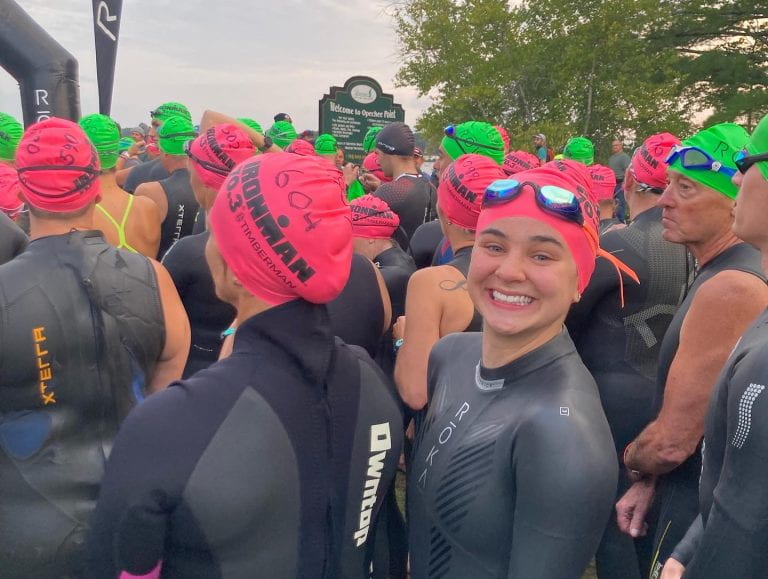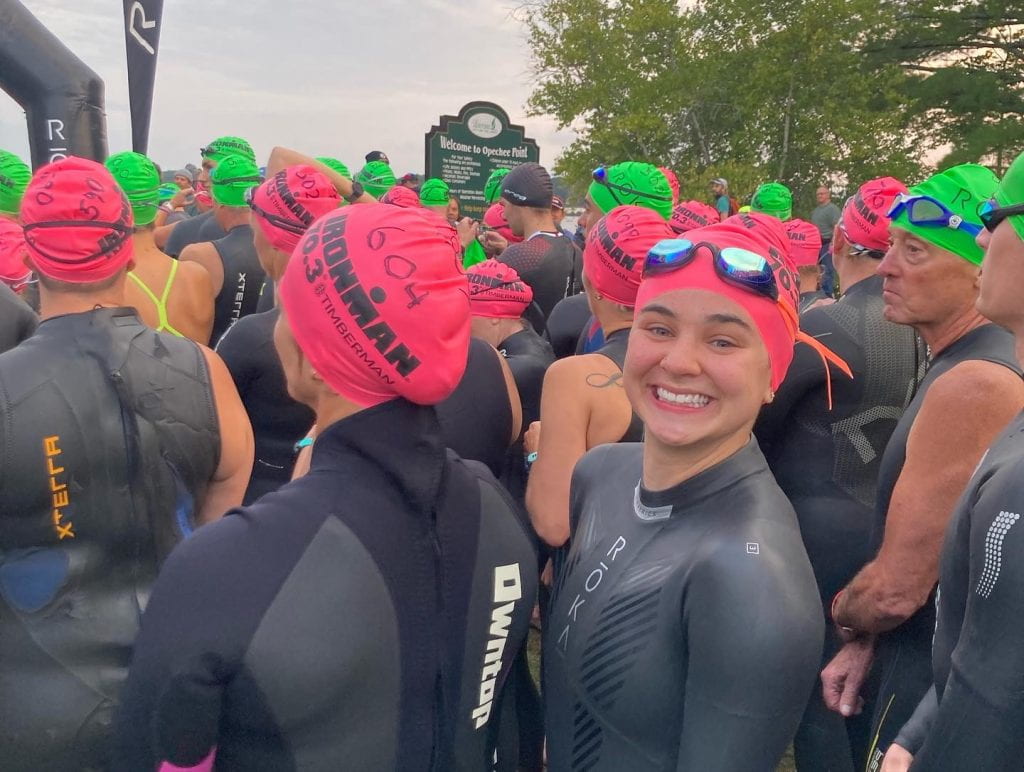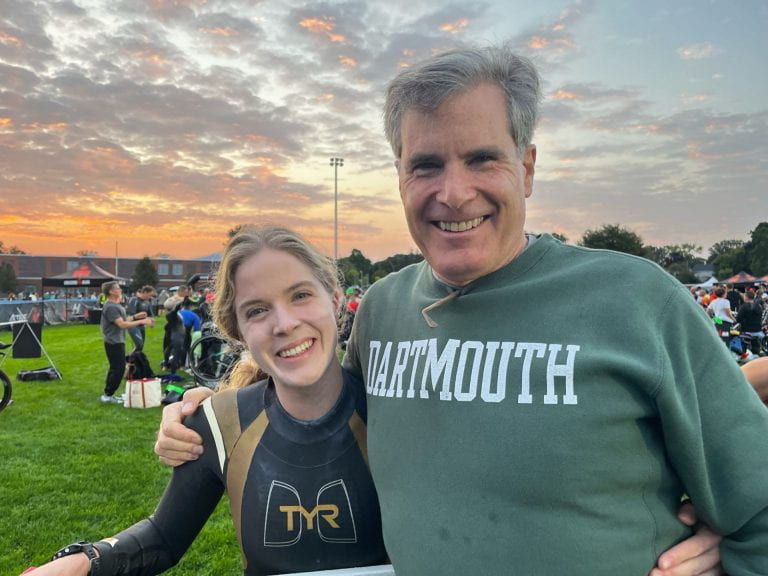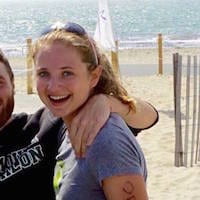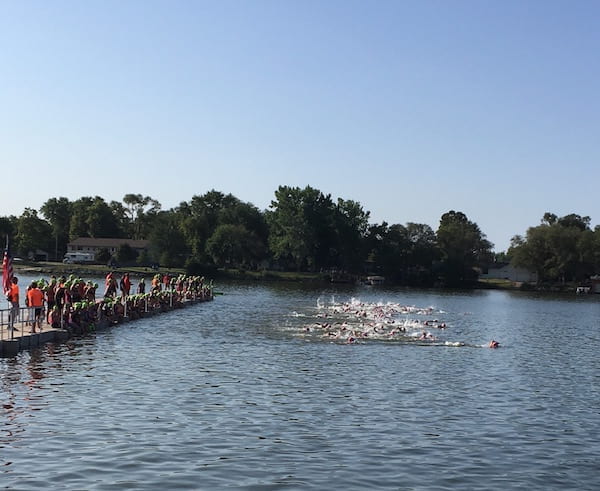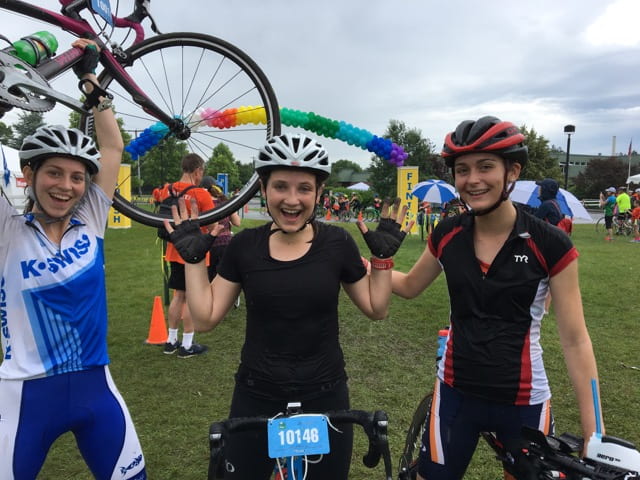This race was daunting at first because of how many "firsts" it carried. To start, I had never participated in a triathlon, brick, aquabike, or any other multisport activity outside of the comfort of Dartmouth. The three-hour drive would displace me from the Dartmouth bubble, and I didn’t know how I would manage in this new land. Secondly, this would be my first time ever trying to race while riding outdoors, instead of using a spin bike as we do in the Indoor Triathlons. I had become comfortable with changing gears and general bike maintenance after I received my team bike a few weeks ago, yet I had been struck with bad luck twice with two flat tires over the span of two weeks. If this were to occur during the actual race, I would be helpless because of how much time it would take me to attempt to fix a flat or any other possible bike hardware issue. Lastly, I was genuinely concerned about my ability to complete the triathlon because my past two Indoor Triathlons only consisted of a 600m swim, 9mi spin, and a 2.6mi run.
The Polar Bear Tri had a slightly shorter swim at 525m, but featured an 11.5 mi bike and 3mi run. While this difference isn’t massive, I was concerned about how there was less of the leg that I was the fastest in and more of the two legs where I am not fast at all. During both the Fall and Winter, I had to stop in the middle of the run a couple times for a breather because of how much I was cramping. Especially combined with how this Triathlon was occurring two weeks earlier in the term than we usually compete, my excitement for this race was being rivaled by my increasing anxiety.
Before the Race
On the Friday we were set to leave for Bowdoin, I was ready as ever to make the three hour trek to Maine. Taper week had gone well, and I thankfully had lots of energy with barely any fatigue. I had been making sure to try and eat more carbs than usual during the few days leading up to the race, while also increasing my electrolyte intake. We finished loading up our bikes in the morning, after I had to leave in the middle of my Chemistry class to get my bike all the way in the River dorms. After changing my van assignment to the earlier group just a few hours before departure, I hurried to my dorm once again to get everything packed. I packed a quick lunch that consisted of two bagels, a banana, and a GU because of this sudden schedule change. Needless to say, I was definitely carb-ed out. We packed the vans, took many headcounts, and then we were off on our way to Brunswick, Maine, vibing out to the fire playlist I helped create.
The drive up was beautiful during this time of the Spring, and we made it to Bowdoin in just three hours, without any stops. We then all went off to run to the restrooms, and as more vans arrived, we took a walk around the pool and transition area to familiarize ourselves with the course. I had never visited Bowdoin or even been Maine before, and the area was extremely picturesque. During this exploration, however, we received news that the truck which was towing our bike trailer had unexpectedly stopped working.

After some investigation from AAA, we figured out that the culprit was diesel fuel in a gas engine (note from trailer crew: "whoops"). Thankfully, we were able to find another truck to bring our bikes over, which meant that we would not be without our bikes during the triathlon, which would have been a ~huge problem~.
After making the 10-minute drive to the hotel to check in and drop off luggage, we then returned to Bowdoin to eat dinner at their dining hall, which we nicknamed BOCO. The food was honestly great, even though it was a Northeaster spin on a Cinco de Mayo dinner. There were plenty of bananas and bagels that made their way into the hands of our many triathletes. As I was heading back to my table after grabbing dessert, I happened to see Spencer standing outside one of the doors in the main dining area. As I pushed the door open to let him in, the loudest alarm came blaring on the speakers. I had opened a fire exit door. As every head in the room turned to me, I couldn’t do anything but just stand there, laughing at my mistake until the alarm died down.

My watch gave me a notice that I had an “unusually high stress level” during that moment. I wonder why…
Once our time in BOCO was over, we headed back to the hotel lobby for a team meeting to end the day. Our coaches, captains, and race planners went over all the necessary logistics for the day tomorrow, which would start with waking up at 5:45 to leave for Bowdoin at 6:30. Everyone parted ways for the night, and soon followed a thousand texts asking if anyone had a pair of scissors to cut no-tie laces, or if anyone could spare an extra race belt. There wasn’t much time between the end of the team meeting and when I wanted to head to bed, so I quickly put on my new laces, triple-checked that I had everything, turned off the lights, and I was soon off to bed.

My sleep wasn’t optimal, but after a few hours of solid sleep it was soon 5:45am, time to start the day! I put on my race kit, stuffed my backpack with everything I would need for the race and the transitions, then I went down to the lobby to meet my fellow teammates for breakfast. My meal was a mixture of the team’s oatmeal and applesauce with the hotel’s cereal, which was honestly great. After leaving the hotel fashionably late as always, the Dartmouth Triathlon Team arrived at Bowdoin at 7am. We immediately encircled the trailer to retrieve our bikes, and then went inside the field house to get our tracking chip and body paint.
When this was all done, we transported our items to the transition area, which took me some time as KW had to craft a makeshift bike plug out of duct tape for me. We ensured that our transition spots were optimized, and then all moved into the stands of the pool to await the announcements that would immediately precede the start of the race. Our team was designated as Wave 4 for our start time, so this meant that we would not start until around 9:10am at the earliest. After some announcements were made on a muffled microphone and the national anthem, the first wave took their places, and with the sound of the buzzer, the race began.
Swim
As I watched the first wave of competitors swim up and down the lanes, I started to try and lock in. The race was real and happening right before my eyes, and in a few minutes, I would be there too. After some anxious stretching pacing, the announcer called for Wave 4 to start lining up around the pool to start. I placed my uneaten gels and granola bars to the side, put on my cap and goggles, and lined up with the dozens of other swimmers in line. The wait took a while at first, but soon I was lined up with Kenna and Robin in one of the 15 lanes. After making some conversation with the volunteer who was operating our lane, it turned out that we actually had many mutual friends. Talking with her in the minutes leading up to the start of my race helped calm my nerves, as it gave me something else to focus on just for a bit. As she notified one of the swimmers in my lane that it was their last lap, I got ready to start. When they got out of the pool on the opposite side, I took a breath, started my watch, jumped in, and began swimming. \

This first leg of the triathlon was by far the one I was most comfortable with, as I had done club swimming in the years past. It was comforting as well to be swimming side-by-side with Kenna, who always is my lane partner during team swim practices. Due to pre-race anxiety, I started off a little faster than my intended pace, so after the first 100m I made an effort to slow down just a bit. Even though this was a sprint triathlon, I was playing the long game. I was doing open turns instead of flip turns, because my flip turn form leaves much to be desired. About halfway through the swim, I began to feel my stomach start to act up a little bit, which had me a little concerned. However, I continued to keep moving forward, increasing my kick cadence near the end to prepare for the transition and the bike that follows. After the 20th lap, the counter notified me that it was my last length by sticking a pole with a large pink sign into the pool. 25 more yards of swimming later, I jumped out of the pool, took off my cap and goggles, and booted it to the transition area.

Bike
As I jogged to where my bike and transition equipment was, I was happy that my legs didn’t feel like jelly. I quickly found my bike and after drying off, put on my socks, shoes, and helmet. I ran with my bike to the wrong exit at first, then after a quick 180º headed the right way to the actual exit. When I saw the marked line with a big sign that said “Mount”, I took a quick swig of water then started the 11.5 mile course.
My main goal during this leg was to focus on breathing and maintain my effort to where I did not exhaust myself, but still was putting out enough energy to maximize my speed. The course didn't start off too steep, and this helped me get my footing and into a good rhythm. Since the course wasn't closed, there were still some cars that would occasionally pass me by, which I wasn't expecting. I was also surprised by the fact that I did not see many other racers on the course, only a handful. The course as a whole was very pretty, and the only feature that stood out to me on the bike course was one hill around the 7 mile mark, but after this was complete, the rest of the course was either flat or downhill. I was able to comfortably reach down to grab and put away my water bottle a couple of times, which was a skill that I had been practicing in the days before.

My legs felt great during the whole ride, but I could tell that my calves were going to be hurting a bit during the run. The main problem, my stomach, didn't get much better from the swim. I remember feeling this before the race started, but I attributed it to just pre-race nerves. However, as I was a few miles into the bike course, it again started to not feel great . I had an energy gel in my back pocket, but I knew that those must be consumed with a good bit of water, which I didn’t have. Instead, I made sure to drink some water every 2-ish miles, and my stomach problems eventually subsided.
The last mile of the ride went by part of the running course, and I was able to cheer on so many of my friends who had already started their last leg of the triathlon. I forgot that the course was 11.5 miles and not 12.5, so when I turned the corner to see the dismount station for the bike, it was definitely a pleasant surprise. I hopped off the bike, ran it back over to the transition area and mounted it on the rack, then took my last drink of water as I buckled my race belt to start the final stretch.
Run
Starting the run, I was immediately thankful for the weather. It was beautiful outside, with 64º weather and enough wind to make it breezy but not cold. There was a stretch of grassy area before the trail in the woods began, which gave me a good opportunity to ease into running. As predicted during the bike, my calves were not stretched enough before the race, but I was determined to finish the run without stopping for a breath or stretch unless absolutely necessary. As I entered the forest that would house the majority of the trail, I was extremely determined to keep my breathing under control so my heart rate would stay low. I was not in Z5 yet, and was trying to hold this off as long as possible.

Leaving the woods, the course passed by a farmer’s market as we turned onto a hill. After climbing the hill, I found myself in a good rhythm going faster than my intended race pace, so I was determined to keep this up through the rest of the race. As I passed by the first aid station, I quickly grabbed a cup of Gatorade that was intended as a drink, but most of it splashed on me instead. This did help me cool down, however, as the temperature was a little warmer than I had expected and I had started to sweat a bit. As I re-entered the trail, the dirt wasn’t too bad on the legs, but obviously since this was near the end of the race, my calves were getting really tight and I could tell I was going to develop a cramp soon. This part of the course was a little windy, which kept me on my toes (literally).
As I approached the second aid station, I did my same maneuver with the Gatorade as the loop portion of the course was approaching. At this section, I would go to the right because I have only taken one loop of the course, while people on their second loop would hang a left. I was feeling very fatigued during this part, but right as I hit the crossroads, I saw so many of my fellow teammates that were cheering me on for my last mile. I used this enthusiasm to power me through the smaller lap of the course which went around the soccer field, and then merged back into the woods onto the main trail. As I passed by the second aid station again, I opted not to go for the Gatorade and instead power through. As my watch buzzed indicated that 3mi had been run, even though I was not at the finish line yet, I took this as a sign to once again increase my pace and cadence for the last stretch of this run. With the end in sight and my friends’ voices in my ears, I sprinted until I was far beyond the finish line, almost running into the guard rails.

After the Race
With hands on the top of my head to catch my breath for the first time in an hour and twenty minutes, I rejoiced in my performance. I was handed a Gatorade and water which I drank with glee, and grabbed a medal as I walked out to congratulate everyone else who had already finished. Looking back, I accomplished my goal of not stopping during the run for a breath, and somehow I had set a PR in my 5k and 400m times - two extremes. My Garmin has always told me that I could run 5k much faster than I had been doing, and I had always thought the technology was wonky. Looking back, I think it was more of a mental game. During and before this race, I had clearly set a goal of how I wanted to perform. When I jumped into the water earlier that morning, I still had the goal in mind, and carried it through to the end.
finisher photo

The following minutes were full of smiles, stretches, and overall satisfaction. Most of the team had already finished, so it was great to reconnect with them after the adventure we just conquered. After some time, we put up our bikes and gathered all of our items from the transition zone just in time to sit down for the awards ceremony. Not surprisingly, our team showed out and we had many awards including in the individual overall categories. When we were finished receiving our many awards and taking group photos, we all headed to our separate vans, and made it home by 3:30 pm.
Looking back at the race as I’m writing this between waddling around campus with my sore legs, I am extremely happy that I came out with the team to race. After battling with all my anxieties surrounding how I would perform, I defied all of them, and I went above and beyond my goals for myself. There is nothing I would have changed about this race (besides maybe not setting off the Bowdoin fire alarm), and I am so happy to be a part of this amazing group.

















